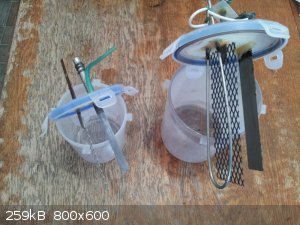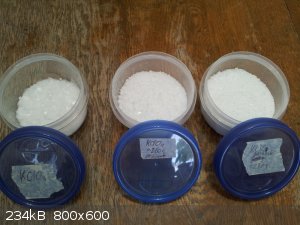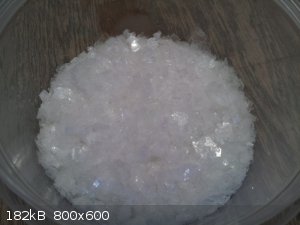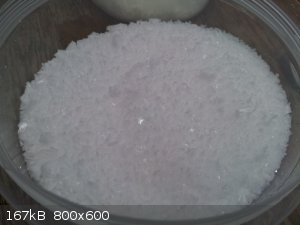| Pages:
1
2
3
..
7 |
Fulmen
International Hazard
    
Posts: 1748
Registered: 24-9-2005
Member Is Offline
Mood: Bored
|
|
Ammonium perchlorate without DIY anodes?
I'm looking at the possibility of making AP, but I do not want to mess with making my own PbO2-anodes. And since they cannot be bought easily, I will
have to find something else.
Although there is a lot of info out there it's not easy to find conclusive answers, so here's a few questions:
MMO (which ones) will work for chlorates, but not perc. Right? And platinized Ti can work for perc, but only in low-chloride conditions. Right?
This presents new problems, as it's not that straightforward to separate NaCl from NaClO3. And since MMO can't handle ClO4 I can't run the cell until
all Cl is converted.
Am I barking up the wrong three or is this doable?
|
|
|
deltaH
Dangerous source of unreferenced speculation
    
Posts: 1663
Registered: 30-9-2013
Location: South Africa
Member Is Offline
Mood: Heavily protonated
|
|
Ruthenium oxide based MMO electrodes have the highest efficiency for generating chlorine, while iridium oxide based MMO are recommended for water
electrolysis (that swear word around here, the HHO cell  ), AFAIK. ), AFAIK.
I do not know much about making perchlorates electrolytically, but it's news to me that you can't use MMO for perchlorates, why?
So since the electrolysis proceeds by generating chlorine at the anode, I'd say go with ruthenium oxide MMO electrodes, unless suggested otherwise by
the many users with experience on such cells here 
BTW, I recall a long while back looking at a table of overpotentials for various electrodes and half reaction occurring on them. The overpotentials
for hydrogen production at the cathode are quite large for many electrodes, so perhaps if you want to drive your cell hard and minimise heating, using
a platinised cathode would work best... provided money is no object 
[Edited on 7-12-2014 by deltaH]
|
|
|
Hennig Brand
International Hazard
    
Posts: 1284
Registered: 7-6-2009
Member Is Offline
Mood: No Mood
|
|
Platinum anodes work great for making perchlorates. They will just need replacement more often if abused.
From: CHLORATES AND PERCHLORATES
THEIR MANUFACTURE, PROPERTIES AND USES
Prepared by
Department of Chemistry and Chemical Engineering
Southwest Research Institute
In the section on Crystallizers (pg. 56):
"In the operation of a typical crystallizer, fed from the chlorate
cells at 104F, containing, for example, 41.0% NaClO3, 9.3% NaCl and the
remainder water, enters the first tank at a rate of 14,450 lb/hr. The
mother liquor which is now cooled to 20F is discharged at a rate of
11,950 lb/hr from the centrifuge for recycling through the first heat
exchanger back to the brine preparation tank. It now contains 28.8%
NaCl03, 11.3% NaCl and the remainder water. The yield is thus 2500 lb/hr
of NaClO3 or 30 ton/day."
If you can find Dann2's site, he had all kinds of phase diagrams and there were some good ones for the sodium chlorate-sodium chloride in water system
from what I remember. IIRC the solubility of sodium chloride changes very little with temperature change, but the solubility of sodium chlorate does.
I also found a few PDFs here which should help you.
http://www.utahpyro.org/compositions/
Attachment: Preparing Chlorates.pdf (115kB)
This file has been downloaded 1473 times
Attachment: Preparing Perchlorates.pdf (60kB)
This file has been downloaded 1449 times
Attachment: Analysis of Perchlorates.pdf (48kB)
This file has been downloaded 1170 times
I don't want to annoy Dann2, but I made PDFs of a lot of his site material a while ago. His site is, or was, a very good resource. Here is the page on
separating sodium chlorate from the electrolyte.
Attachment: Removal of Sodium Chlorate.pdf (233kB)
This file has been downloaded 1761 times
[Edited on 7-12-2014 by Hennig Brand]
"A risk-free world is a very dull world, one from which we are apt to learn little of consequence." -Geerat Vermeij
|
|
|
Bert
Super Administrator
        
Posts: 2821
Registered: 12-3-2004
Member Is Offline
Mood: " I think we are all going to die. I think that love is an illusion. We are flawed, my darling".
|
|
As the OP didn't reference his statements-
And we have been here before-
I am going to merge this with an existing thread.
I would prefer that OP select from the MANY relevant threads-
BTW, this popped out at me while scanning those existing threads...
http://www.sciencemadness.org/talk/files.php?pid=140798&...
[Edited on 7-12-2014 by Bert]
Rapopart’s Rules for critical commentary:
1. Attempt to re-express your target’s position so clearly, vividly and fairly that your target says: “Thanks, I wish I’d thought of putting it
that way.”
2. List any points of agreement (especially if they are not matters of general or widespread agreement).
3. Mention anything you have learned from your target.
4. Only then are you permitted to say so much as a word of rebuttal or criticism.
Anatol Rapoport was a Russian-born American mathematical psychologist (1911-2007).
|
|
|
jock88
National Hazard
   
Posts: 505
Registered: 13-12-2012
Member Is Offline
Mood: No Mood
|
|
Dann2's page is now here
http://oxidizing.typhoonguitars.com/
Some of the stuff of the http://www.utahpyro.org/compositions/ site (pasted below) is nonsence.
*start of quote*
...................
.....................
Electrode materials for perchlorate manufacture.
DSA: DSA stands for Dimensionally Stable Anode. This is the common term used to
refer to anodes consisting of a layer of noble metal oxides (usually RuO2 and TiO2)
coated onto a substrate, usually titanium. This type of anode is finding increased use in
industrial cells because of its comparatively low cost when compared to platinum and its
resistance to corrosion. The chemicals required to manufacture these anodes are
expensive and difficult to handle. However, if the chemicals can be obtained and suitable
equipment is available, the procedure to make the anode seems fairly straightforward and
may be an option. For the preparation of these, the reader is referenced to the literature.
Again, I'd be most interested in anyone’s experiences with this type of anode.
Magnetite: This material has found use in industry in the past, but is rarely used
nowadays due to its relatively high corrosion rate and low efficiency for perchlorate
manufacture. The anodes are made by melting and casting FeO.Fe2O3 into the required
anode shapes. I have little literature available on this material, so it is not further
discussed here. *end of quote*
|
|
|
Fulmen
International Hazard
    
Posts: 1748
Registered: 24-9-2005
Member Is Offline
Mood: Bored
|
|
My apologies for bad search-fu. I will try to do better in the future.
Also, thanks for all the data, I'll be sure to read them thoroughly before asking more stupid questions. I figured I would have to precipitate out the
NaCl, but if I can precipitate out NaClO3 then it doesn't seem like a big issue after all. After all I don't have to remove all of it, the liquor can
be recycled.
DeltaH: I haven't figured out why yet (or even if), but from what I've read MMO and perchlorate isn't a good combo. But there seems to be a great deal
of confusion on the subject, some sources say that platinum works for perchlorate but is sensitive to chlorides, others say it's a good choice for
chlorate as well. I need to be sure before I make a decision, I don't want a long-winded research project trying to figure out why expensive anodes go
*pooof*.
|
|
|
morganbw
National Hazard
   
Posts: 561
Registered: 23-11-2014
Member Is Offline
Mood: No Mood
|
|
Quote: Originally posted by jock88  |
Dann2's page is now here
http://oxidizing.typhoonguitars.com/
Some of the stuff of the http://www.utahpyro.org/compositions/ site (pasted below) is nonsence.
*start of quote*
...................
.....................
Electrode materials for perchlorate manufacture.
DSA: DSA stands for Dimensionally Stable Anode. This is the common term used to
refer to anodes consisting of a layer of noble metal oxides (usually RuO2 and TiO2)
coated onto a substrate, usually titanium. This type of anode is finding increased use in
industrial cells because of its comparatively low cost when compared to platinum and its
resistance to corrosion. The chemicals required to manufacture these anodes are
expensive and difficult to handle. However, if the chemicals can be obtained and suitable
equipment is available, the procedure to make the anode seems fairly straightforward and
may be an option. For the preparation of these, the reader is referenced to the literature.
Again, I'd be most interested in anyone’s experiences with this type of anode.
Magnetite: This material has found use in industry in the past, but is rarely used
nowadays due to its relatively high corrosion rate and low efficiency for perchlorate
manufacture. The anodes are made by melting and casting FeO.Fe2O3 into the required
anode shapes. I have little literature available on this material, so it is not further
discussed here. *end of quote*
|
I can see that it may not do well for perchlorate but for chlorate???? why is it nonsense.
|
|
|
Hennig Brand
International Hazard
    
Posts: 1284
Registered: 7-6-2009
Member Is Offline
Mood: No Mood
|
|
Most, or all, commonly available DSA/MMO anodes are not suitable at all for making perchlorates. However, it seems that it is possible to make DSA
that are. I found a reference to the following patent on Dann2's site.
Attachment: US4267025 Electrodes for Electrolytic Processes, Especially Perchlorate Production.pdf (363kB)
This file has been downloaded 909 times
It is also possible, given the description in the text, that the Utah pyro people put the wrong heading on that section. It isn't that hard to mix up
chlorate and perchlorate. It sounds like they were talking about producing an experimental Dimensionally Stable Anode, however, especially since he
says or implies at the end that he has never tried it and would be interested to hear of any ones experiences if they make one. Since the common MMO
anodes are so cheap and readily available it makes a lot of sense that if one is going through the trouble to make one that it would be so it could do
things the readily available varieties couldn't (make perchlorates).
[Edited on 7-12-2014 by Hennig Brand]
"A risk-free world is a very dull world, one from which we are apt to learn little of consequence." -Geerat Vermeij
|
|
|
Fulmen
International Hazard
    
Posts: 1748
Registered: 24-9-2005
Member Is Offline
Mood: Bored
|
|
That was my impression as well, none of the readily available MMO's were suited for perchlorate. And this is an absolute requirement for me, readily
available, long lasting anodes. I did read something about platinum not being the best option or a chlorate cell, but I can't remember where i found
that.
|
|
|
Hennig Brand
International Hazard
    
Posts: 1284
Registered: 7-6-2009
Member Is Offline
Mood: No Mood
|
|
I think with Dann2's site and the other links you will find everything you need, if you take your time and read through it. Personally I would
probably use graphite anodes to make sodium chlorate; removing crops of sodium chlorate and recharging the electrolyte with more sodium chloride and
water at the appropriate times. There are ways to filter out the really fine carbon dust from carbon anode erosion; filtering through a layer of
diatomaceous earth is one way. Once I had sodium chlorate of high purity (sodium chloride in low concentration is bad for platinum anodes), I would
produce sodium perchlorate using a platinum anode of some sort (what I have now is a platinum coated titanium anode).
"A risk-free world is a very dull world, one from which we are apt to learn little of consequence." -Geerat Vermeij
|
|
|
jock88
National Hazard
   
Posts: 505
Registered: 13-12-2012
Member Is Offline
Mood: No Mood
|
|
From this link
http://oxidizing.typhoonguitars.com/chlorate/leaddiox/platin...
To quote:
In effect, platinum forms an equilibrium or quasi equilibrium state when evolving chlorine, and a rather different state for oxygen evolution. During
co-joint oxygen and chlorine evolution, which occurs in dilute brine, there is interference in the formation of surface layers and this leads to
accentuated metal dissolution.(Platinum Metals Rev., 1998, 42, (l), 27-33, available below)
The above will occur when a chlorate cell is getting very low in chloride (it will be very high in Chlorate) and perhaps on the verge or just
starting to make perchlorate.
Those titanium + a platinum coating a few microns thick will be eaten away pronto and you are down the price of the anode.
The crucible seems a great idea.
|
|
|
deltaH
Dangerous source of unreferenced speculation
    
Posts: 1663
Registered: 30-9-2013
Location: South Africa
Member Is Offline
Mood: Heavily protonated
|
|
@Fulmen,
Have you tried calling up a technical advisor in a MMO electrode producing company?
|
|
|
Fulmen
International Hazard
    
Posts: 1748
Registered: 24-9-2005
Member Is Offline
Mood: Bored
|
|
Jock: Thank you for that link, that was the information I was looking for. It seems Pt can be used for ClO3 as well, as long as the Cl-concentration
isn't too low. And there really isn't any reason for running a cell to pure ClO3, but considering the cost of a MMO-anode it seems safer to run two
separate setups.
The wear rate of 2-7g Pt/ton ClO4 doesn't seem that bad, but most platinized anodes are only 2,5 microns thick. Not sure how much ClO4 I can expect
before the coating gives, but it seems like the best route all in all. Solid Pt is just too darn expensive considering the surface area available and
the recommended current densities.
|
|
|
Hennig Brand
International Hazard
    
Posts: 1284
Registered: 7-6-2009
Member Is Offline
Mood: No Mood
|
|
You shouldn't be completely resistant to doing some research on your own. Dann2's site is laid out very well for easy digestion. You will learn many
things you didn't realize you didn't know, when searching for the things you knew you didn't know. The quality of learning in general will be better.
BTW, I am still an amateur at this as well.
I dug through some old boxes and found a couple of old improvised cells, with commercial anodes, that were used on a window ledge to produce chlorate
and perchlorate. The vessels were food storage containers, with sealable lids, from the local dollar store. The large one, which was used to produce
chlorate, has a MMO anode and SS cathodes. The small one, which was used to produce perchlorate, has a platinized titanium anode and a titanium
cathode. I found some of the potassium chlorate and perchlorate that was last produced with these cells too in the same boxes. The cells were last run
about six years ago.
 

 
[Edited on 8-12-2014 by Hennig Brand]
"A risk-free world is a very dull world, one from which we are apt to learn little of consequence." -Geerat Vermeij
|
|
|
Fulmen
International Hazard
    
Posts: 1748
Registered: 24-9-2005
Member Is Offline
Mood: Bored
|
|
I'm not worried about that part, just getting the cell to run properly and refining the product should provide more than enough research to keep me
busy for a while. The more I read up on the subject the more sense PbO2 seems to make, sadly I'm not set up to do that kind of work. Nor am I
interested in a long-winded project just to get working anodes. MMO and Pt seems like my best options for now, I do have graphite for a chlorate
test-run but not enough to use it for a permanent setup. Besides, filtering can be much more problematic than people think, so I don't mind skipping
that part if I can.
I'm still reading up on the purification part and pondering how to organize the production sensibly. For a few runs you can always wing it, but for a
more permanent setup I really need a good, predictable procedure and some way of determining quality. That is the real challenge here I think, the
cell itself isn't that complex project.
|
|
|
Fulmen
International Hazard
    
Posts: 1748
Registered: 24-9-2005
Member Is Offline
Mood: Bored
|
|
Well, this seems quite doable. A 3x6" MMO-anode should be more than enough, if I assume the surface area is roughly equal to it's overall dimensions
and a current density of 250mA/cm^2 it should be able to handle more than 50A and capable of producing roughly 500g per day! Now THAT is a cell I'd
like to build 
A more realistic setup is 4A, 250ml volume and roughly 250g/week. The real challenge seems to lie in the purification. The thought of ammonium
chlorate in the final product has a pretty high pucker-factor, so I'll have to find a reliable analysis. Luckily several exist, are there any more to
consider than those listed here?
http://www.oocities.org/capecanaveral/campus/5361/chlorate/t...
And if anyone has experience with these I'd like to hear of them. The Indigo Carmine-test seems promising, so does the ammonium thiocyanate rapid
test.
[Edited on 10-12-14 by Fulmen]
|
|
|
Hennig Brand
International Hazard
    
Posts: 1284
Registered: 7-6-2009
Member Is Offline
Mood: No Mood
|
|
I have Indigo Carmine, but I didn't get it until after I made the last batch of potassium perchlorate. I just boiled the crude sodium perchlorate
dissolved in water with a fairly large excess of sodium metabisulfite and hydrochloric acid for much longer than a normal treatment. A test to be sure
all chlorate is destroyed is a good idea though, especially if it will be used to produce ammonium perchlorate.
"A risk-free world is a very dull world, one from which we are apt to learn little of consequence." -Geerat Vermeij
|
|
|
Fulmen
International Hazard
    
Posts: 1748
Registered: 24-9-2005
Member Is Offline
Mood: Bored
|
|
Huh, I just found Methylene Blue B in my chem collection, not sure if I'll ever need it but it's nice to know I have it. As for the chlorate, Indigo
Carmine seems to be the most sensitive test (ppm-levels) and not too complicated to perform.
As for the cell, Yates has a good point about it being more sensible to keep the chloride levels high than to mess with pH-adjustments. This presents an elegant
option for chlorate extraction. By insulating/heating the cell so that cooling is required, the cooler should precipitate chlorate. The cell is kept
saturated by adding solid NaCl.
Another option that should be more energy efficient is to use a heat exchanger to minimize heat losses, but I'm afraid that this would clog out due to
precipitation.
|
|
|
Fulmen
International Hazard
    
Posts: 1748
Registered: 24-9-2005
Member Is Offline
Mood: Bored
|
|
Funny how one thing leads to another, I've been slightly side-tracked by the need for a rugged CC/CV PSU. It's basically a 12V/10A PSU and a couple of
buck / boost regulators I've bought from DX for other projects. Still waiting for potentiometers to replace the on-board ones for panel mounts, so I
finished a jam-jar prototype cell during the holidays using graphite / copper electrodes. Seems to work fine, but getting the darn thing air tight
isn't easy. Outside is exposed to wind and snow, so I need to take precautions before I can run it outside. Thought I could pull off a trial run
inside, didn't take me many minutes to realize that's not an option.
Seems to work fine though judging by the amount of chlorine gas that leaked out *cough* 
Don't worry, I'm going to play nice with that stuff. Those that have been even mildly poisoned by chlorine gas will know how bad it really is, caught
a lung-full at a plant I worked at and damn what a shitty day that turned out to be.
|
|
|
Hennig Brand
International Hazard
    
Posts: 1284
Registered: 7-6-2009
Member Is Offline
Mood: No Mood
|
|
I had mine vented to the outside, through a piece of plastic tubing, which worked fine, but running a cell outside is obviously the safest if it is
feasible. A long drill bit, like the ones cable and satellite dish installers use when drilling holes to run wires, was used to drill a hole through
the wall just beside the window frame, or through the window frame itself, to run the tubing through to the outdoors. Yeah, chlorine gas is not
healthy at all. IIRC, once the chlorate cell has been running a while, and the pH rises, the amount of chlorine production tapers off, unless of
course acid is being added to keep the pH down.
"A risk-free world is a very dull world, one from which we are apt to learn little of consequence." -Geerat Vermeij
|
|
|
Fulmen
International Hazard
    
Posts: 1748
Registered: 24-9-2005
Member Is Offline
Mood: Bored
|
|
After some work sealing up the lid it now runs fine indoors. The gas is bubbled through NaOH, can't smell any chlorine leaving. As you say, after a
short while the pH drops enough to limit the amount of Cl2 that comes off.
But it's clear that graphite isn't my cup of tea, in fact the cell looks like a cup of strong coffee. So I do think I will need to order some anodes
for this.
|
|
|
Hennig Brand
International Hazard
    
Posts: 1284
Registered: 7-6-2009
Member Is Offline
Mood: No Mood
|
|
The following was taken from Dann2's site, from the page called "Reaction equations".
"At a low pH the cell will generate Chlorine gas which will escape out of the cell and this will cause the pH to increase. As the pH rises the ease
with which Chlorine can escape out of the cell gets less and less and the cell will stabilize at a pH of about 9 or 10. At this high pH, practically
all Chlorate is made by electricity by the Anodic Oxidation of the Hypochlorous ion (also known as Anodic Chlorate formation, or 'making Chlorate by
electricity', or electrochemical Chlorate formation) at a maximum possible current efficiency of 66.66%, the nine electron route."
When I used the copper coated carbon rods I would carefully remove/peel the copper off of the rod except for a bit at one end to allow a better
electrical connection with the supply wire. I tried several different glues and things to seal the electrodes in the top of the cells and I remember
some lasted better than others, but I would have to go back and check and refresh my memory on which ones were better. I believe I used hot melt glue
a lot of the time, which wasn't permanent but stood up reasonably well. It goes without saying that a vessel with a lid that seals well is required.
The containers in the picture I posted a couple of posts up were a cheap dollar store variety, but they have a very good soft silicon seal for the
cover.
[Edited on 31-12-2014 by Hennig Brand]
"A risk-free world is a very dull world, one from which we are apt to learn little of consequence." -Geerat Vermeij
|
|
|
Fulmen
International Hazard
    
Posts: 1748
Registered: 24-9-2005
Member Is Offline
Mood: Bored
|
|
I'm using a plain jam jar with a metal screw-on lid, the connections are sealed with a screw and rubber gasket. Seems to be fairly tight, how the lid
fares over time remains to be seen. I will need a better container somewhere along the way but it works for testing purposes.
It's currently running at 4A @ 3,2V, efficiency is anybodys guess but I'm satisfied with 50%. As for pH control I do have a pH-meter but I'm not sure
how well it will handle this environment. It's too much hassle anyway, so unless someone finds a simpler method for measuring this I''m going to leave
the pH as it is.
|
|
|
Hennig Brand
International Hazard
    
Posts: 1284
Registered: 7-6-2009
Member Is Offline
Mood: No Mood
|
|
I never bothered with pH control so far. Controlling pH makes things more complicated.
"A risk-free world is a very dull world, one from which we are apt to learn little of consequence." -Geerat Vermeij
|
|
|
Fulmen
International Hazard
    
Posts: 1748
Registered: 24-9-2005
Member Is Offline
Mood: Bored
|
|
From what I've read chlorate cells seems to be rat poison for pH-probes. I won't risk mine on it, so until a better method is devised I'll simply have
to live without it.
I've thought about voltammetry of some sort, perhaps a pH-dependent passivation reaction that would give a useful value. But I suspect that brighter
heads have thought long and hard about this, and nobody seems to have a good solution.
|
|
|
| Pages:
1
2
3
..
7 |